CPAT Events
The CPAT includes eight sequential events as follows:
- Event 1: Stair Climb
- Event 2: Hose Drag
- Event 3: Equipment Carry
- Event 4: Ladder Raise and Extension
- Event 5: Forcible Entry
- Event 6: Search
- Event 7: Rescue
- Event 8: Ceiling Breach and Pull
Event 1: Stair Climb
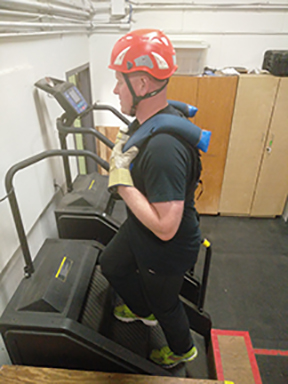 Equipment
Equipment
This event uses a StepMill stair-climbing machine. The machine is positioned with one side up against a wall and an elevated proctor platform on the side opposite the wall. A single handrail on the wall side is available for you to grasp while mounting and dismounting the StepMill. Additional steps are placed at the base of the StepMill to assist you in mounting the StepMill.
Purpose of Evaluation
This event is designed to simulate the critical tasks of climbing stairs in full protective clothing while carrying a high-rise pack (hose bundle), as well as climbing stairs in full protective clothing while carrying firefighter equipment. This event challenges your aerobic capacity, lower body muscular endurance, and ability to balance. This event affects your aerobic energy system and the following muscle groups: quadriceps, hamstrings, glutes, calves, and lower back stabilizers.
Event
For this event, you must wear two 12.5-pound (5.67-kg) weights on your shoulders to simulate the weight of a high-rise pack. Prior to the initiation of the timed CPAT, there is a 20 second warm-up on the StepMill at a set stepping rate of 50 steps per minute. During this warm-up period, you are permitted to dismount, grasp the rail, or hold the wall to establish balance and cadence. If you fall or dismount the StepMill during the 20-second warm-up period, you must remount the StepMill and restart the entire 20-second warm-up period. You are allowed to restart the warm-up period twice. The timing of the test begins at the end of this warm-up period when the proctor calls the word "START." There is no break in time between the warm-up period and the actual timing of the test. For the test, you must walk on the StepMill at a set stepping rate of 60 steps per minute for 3 minutes. This concludes the event. The two 12.5-pound (5.67-kg) weights are removed from your shoulders. Walk 85 feet (25.91 m) within the established walkway to the next event.
Failures
If you fall or dismount the StepMill three times during the warm-up period, you fail the test. If you fall, grasp any of the test equipment, or dismount the StepMill after the timed CPAT begins, the test is concluded and you fail the test. During the test, you are momentarily permitted to touch the wall or handrail for balance. However, if the wall or handrail is grasped or touched for an extended period of time, or if the wall or handrail is used for weight bearing, you are warned. Only two warnings are given. The third infraction constitutes a failure, the test time is concluded and you fail the test.
Event 2: Hose Drag
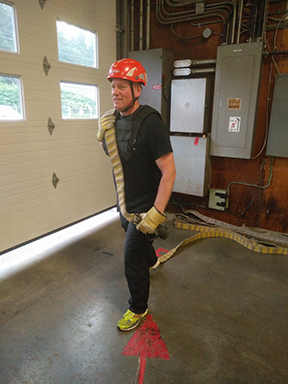 Equipment
Equipment
This event uses an uncharged fire hose with a hoseline nozzle. The hoseline is marked at eight feet (2.24 m) past the coupling at the nozzle to indicate the maximum amount of hose you are permitted to drape across your shoulder or chest. The hoseline is also marked at 50 feet (15.24 Fm) past the coupling at the nozzle to indicate the amount of hoseline that you must pull into a marked boundary box before completing the test.
Purpose of Evaluation
This event is designed to simulate the critical tasks of dragging an uncharged hoseline from the fire apparatus to the fire occupancy and pulling an uncharged hoseline around obstacles while remaining stationary. This event challenges your aerobic capacity, lower body muscular strength and endurance, upper back muscular strength and endurance, grip strength and endurance, and anaerobic endurance. This event affects your aerobic and anaerobic energy systems, as well as the following muscle groups: quadriceps, hamstrings, glutes, calves, lower back stabilizers, biceps, deltoids, upper back, and muscles of the forearm and hand (grip).
Event
For this event, you must grasp a hoseline nozzle attached to 200 feet (60 m) of 1 3/4-inch (44-mm) hose. Place the hoseline over your shoulder or across your chest, not exceeding the 8-foot (2.24-m) mark. You are permitted to run during the hose drag. Drag the hose 75 feet (22.86 m) to a prepositioned drum, make a 90 degree turn around the drum, and continue an additional 25 feet (7.62 m). Stop within the marked 5 foot x 7 foot (1.52 m x 2.13 m) box, drop to at least one knee and pull the hoseline until the hoseline's 50-foot (15.24 m) mark crosses the finish line. During the hose pull, you must keep at least one knee in contact with the ground and knee(s) must remain within the marked boundary lines. This concludes the event. Walk 85 feet (25.91 m) within the established walkway to the next event.
Failures
During the hose drag, if you fail to go around the drum or go outside of the marked path (cones), the test time is concluded and you fail the test. During the hose pull, you are warned if at least one knee is not kept in contact with the ground. The second infraction constitutes a failure, the test time is concluded and you fail the test. During hose pull, you are warned if your knees go outside the marked boundary line. The second infraction constitutes a failure, the test time is concluded and you fail the test.
Event 3: Equipment Carry
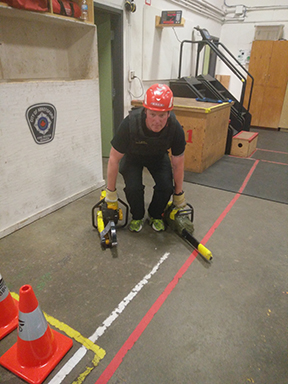 Equipment
Equipment
This event uses two saws and a tool cabinet replicating a storage cabinet on a fire truck.
Purpose of Evaluation
This event is designed to simulate the critical tasks of removing power tools from a fire apparatus, carrying them to the emergency scene, and returning the equipment to the fire apparatus. This event challenges your aerobic capacity, upper body muscular strength and endurance, lower body muscular endurance, grip endurance, and balance. This event affects your aerobic energy system as well as the following muscle groups: biceps, deltoids, upper back, trapezius, muscles of the forearm and hand (grip), glutes, quadriceps, and hamstrings.
Event
For this event, you must remove the two saws from the tool cabinet, one at a time, and place them on the ground. Pick up both saws, one in each hand, and carry them while walking 75 feet (22.86 m) around the drum, then back to the starting point. You are permitted to place the saw(s) on the ground and adjust your grip. Upon return to the tool cabinet, place the saws on the ground, pick up each saw one at a time, and replace the saw in the designated space in the cabinet. This concludes the event. Walk 85 feet (25.91 m) within the established walkway to the next event.
Failures
If you drop either saw on the ground during the carry, the test time is concluded and you fail the test. You receive one warning for running. The second infraction constitutes a failure, the test time is concluded and you fail the test.
Event 4: Ladder Raise and Extension
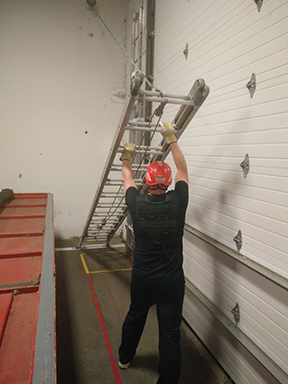 Equipment
Equipment
This event uses two 24-foot (7.32-m) fire department ladders. For your safety, a retractable lanyard is attached to the ladder that you raise.
Purpose of Evaluation
This event is designed to simulate the critical tasks of placing a ground ladder at a fire structure and extending the ladder to the roof or window. This event challenges your aerobic capacity, upper body muscular strength, lower body muscular strength, balance, grip strength, and anaerobic endurance. This event affects your aerobic and anaerobic energy systems as well as the following muscle groups: biceps, deltoids, upper back, trapezius, muscles of the forearm and hand (grip), glutes, quadriceps, and hamstrings.
Event
For this event, you must walk to the top rung of the 24-foot (7.32-m) aluminum extension ladder, lift the unhinged end from the ground, and walk it up until it is stationary against the wall. This must be done in a hand over hand fashion, using each rung until the ladder is stationary against the wall. You must not use the ladder rails to raise the ladder. Immediately proceed to the prepositioned and secured 24-foot (7.32 m)aluminum extension ladder, stand with both feet within the marked box of 36 inches x 36 inches (91.44 cm x 91.44 cm), and extend the fly section hand over hand until it hits the stop. Then, lower the fly section hand over hand in a controlled fashion to the starting position. This concludes the event. Walk 85 feet (25.91 m) within the established walkway to the next event.
Failures
If you miss any rung during the raise, one warning is given. The second infraction constitutes a failure, the test time is concluded and you fail the test. If you allow the ladder to fall to the ground or the safety lanyard is activated because you released your grip on the ladder, the test time is concluded and you fail the test. If during the ladder extension, your feet do not remain within marked boundary lines, one warning is given. The second infraction constitutes a failure, the test time is concluded and you fail the test. If you do not maintain control of the ladder in a hand over hand manner, or let the rope halyard slip in an uncontrolled manner, your test time is concluded and you fail the test.
Event 5: Forcible Entry
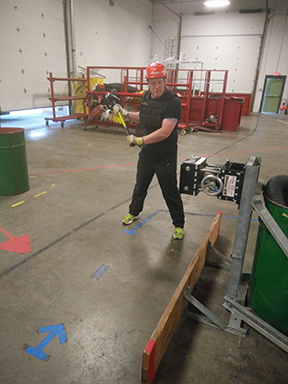 Equipment
Equipment
This event uses a mechanized device located 39 inches (1 m) off the ground that measures cumulative force from a 10-pound (4.54-kg) sledgehammer.
Purpose of Evaluation
This event is designed to simulate the critical tasks of using force to open a locked door or to breach a wall. This event challenges your aerobic capacity, upper body muscular strength and endurance, lower body muscular strength and endurance, balance, grip strength and endurance, and anaerobic endurance. This event affects your aerobic and anaerobic energy systems as well as the following muscle groups: quadriceps, glutes, triceps, upper back, trapezius, and muscles of the forearm and hand (grip).
Event
For this event, you must use a 10-pound (4.54 kg) sledgehammer to strike the measuring device in the target area until the buzzer is activated. During this event, you must keep your feet outside the toe-box at all times. After the buzzer is activated, place the sledgehammer on the ground. This concludes the event. Walk 85 feet (25.91 m) within the established walkway to the next event.
Failures
If you do not maintain control of the sledgehammer and release it from both hands while swinging, it constitutes a failure, the test time is concluded and you fail the test. If you step inside the toe-box, one warning is given. The second infraction constitutes a failure, the test time is concluded and you fail the test.
Event 6: Search
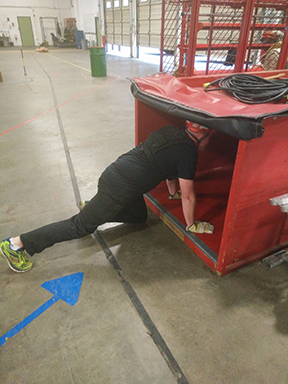 Equipment
Equipment
This event uses an enclosed search maze that has obstacles and narrowed spaces.
Purpose of Evaluation
This event is designed to simulate the critical task of searching for a fire victim with limited visibility in an unpredictable area. This event challenges your aerobic capacity, upper body muscular strength and endurance, agility, balance, anaerobic endurance, and kinesthetic awareness. This event affects your aerobic and anaerobic energy systems as well as the following muscle groups: muscles of the chest, shoulder, triceps, quadriceps, abdominals, and lower back.
Event
For this event, you must crawl through a tunnel maze that is approximately 3 feet (91.44 cm) high, 4 feet (121.92 cm) wide and 64 feet (19.51 m) in length with two 90 degree turns. At a number of locations in the tunnel, you must navigate around, over, and under obstacles. In addition, at two locations, you must crawl through a narrowed space where the dimensions of the tunnel are reduced. Your movement is monitored through the maze. If for any reason you choose to end the event, call out or rap sharply on the wall or ceiling and you will be assisted out of the maze. Upon exit from the maze, the event is concluded. Walk 85 feet (25.91 m) within the established walkway to the next event.
Failures
A request for assistance that requires the opening of the escape hatch or opening of the entrance/exit covers constitutes a failure, the test time is concluded and you fail the test.
Event 7: Rescue
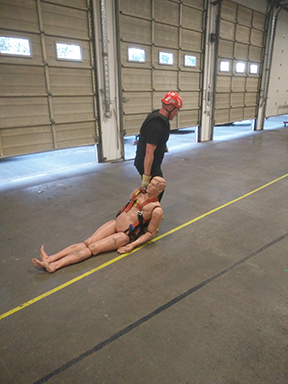 Equipment
Equipment
This event uses a weighted mannequin equipped with a harness with shoulder handles.
Purpose of Evaluation
This event is designed to simulate the critical task of removing a victim or injured partner from a fire scene. This event challenges your aerobic capacity, upper and lower body muscular strength and endurance, grip strength and endurance, and anaerobic endurance. This event affects your aerobic and anaerobic energy systems as well as the following muscle groups: quadriceps, hamstrings, glutes, abdominals, torso rotators, lower back stabilizers, trapezius, deltoids, latissimus dorsi, biceps, and muscles of the forearm and hand (grip).
Event
For this event, you must grasp a 165-pound (74.84 kg) mannequin by the handle(s) on the shoulder(s) of the harness (either one or both handles are permitted), drag it 35 feet (10.67 m) to a prepositioned drum, make a 180 degree turn around the drum, and continue an additional 35 feet (10.67 m) to the finish line. You are not permitted to grasp or rest on the drum. It is permissible for the mannequin to touch the drum. You are permitted to drop and release the mannequin and adjust your grip. The entire mannequin must be dragged until it crosses the marked finish line. This concludes the event. Walk 85 feet (25.91 m) within the established walkway to the next event.
Failures
If you grasp or rest on the drum at any time, one warning is given. The second infraction constitutes a failure, the test time is concluded and you fail the test.
Event 8: Ceiling Breach and Pull
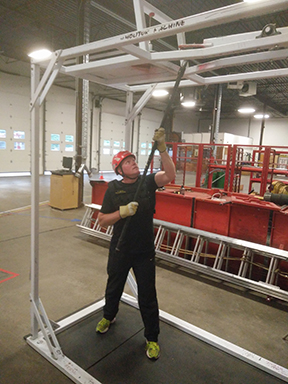 Equipment
Equipment
This event uses a pike pole and a mechanized device that measures overhead push and pull. The pike pole is a commonly used piece of equipment that consists of a six-foot long pole with a hook and point attached to one end.
Purpose of Evaluation
This event is designed to simulate the critical task of breaching and pulling down a ceiling to check for fire extension. This event challenges your aerobic capacity, upper and lower body muscular strength and endurance, grip strength and endurance, and anaerobic endurance. This event affects your aerobic and anaerobic energy systems as well as the following muscle groups: quadriceps, hamstrings, glutes, abdominals, torso rotators, lower back stabilizers, deltoids, trapezius, triceps, biceps, and muscles of the forearm and hand (grip).
Event
For this event, you must remove the pike pole from the bracket, stand within the boundary established by the equipment frame, and place the tip of the pole on the painted area of the hinged door in the ceiling. Fully push up the 60-pound hinged door in the ceiling with the pike pole three times. Then, hook the pike pole to the 80-pound ceiling device and pull the pole down five times. Each set consists of three pushes and five pulls. Repeat the set four times. You are permitted to stop and, if needed, adjust your grip. Releasing your grip or allowing the pike pole handle to slip, without the pike pole falling to the ground, does not result in a warning or constitute a failure. You are permitted to reestablish your grip and resume the event. If you do not successfully complete a repetition, the proctor calls out "MISS" and you must push or pull the apparatus again to complete the repetition. This event and the total test time ends when you complete the final pull stroke repetition as indicated by a proctor who calls out "TIME."
Failures
One warning is given if you drop the pike pole to the ground. If you drop the pike pole, you must pick it up without proctor assistance and resume the event. The second infraction constitutes a failure, the test time is concluded and you fail the test. If your feet do not remain within the marked boundary lines, one warning is given. The second infraction constitutes a failure, the test time is concluded and you fail the test.